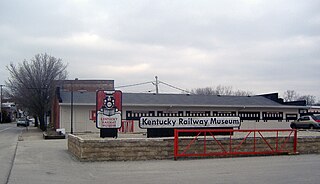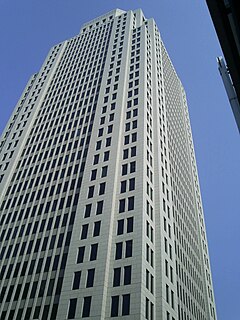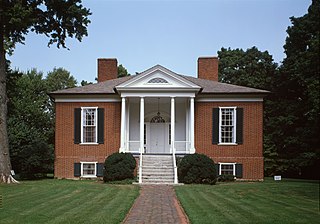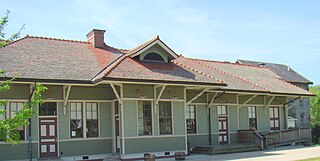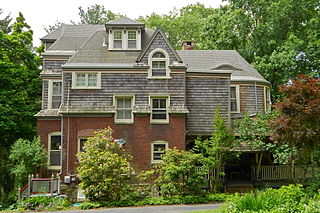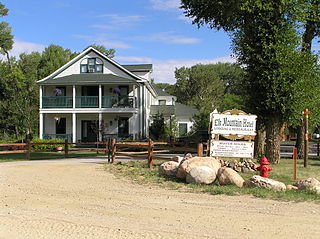New Sherwood Hotel | |
Front view of the New Sherwood Hotel | |
| Location | 138 South Main Street, New Haven, Kentucky |
|---|---|
| Coordinates | 37°39′26″N85°35′37″W / 37.65722°N 85.59361°W Coordinates: 37°39′26″N85°35′37″W / 37.65722°N 85.59361°W |
| Built | 1914 |
| Architect | Johnson, W.F.; Hizer, Charlie |
| Architectural style | Late 19th And Early 20th Century American Movements |
| NRHP reference # | 92000291 [1] |
| Added to NRHP | March 26, 1992 |
The New Sherwood Hotel is a historic property on the National Register of Historic Places in New Haven, Kentucky, in southernmost Nelson County, Kentucky. It is next door to the Kentucky Railway Museum on U.S. 31E.

The National Register of Historic Places (NRHP) is the United States federal government's official list of districts, sites, buildings, structures, and objects deemed worthy of preservation for their historical significance. A property listed in the National Register, or located within a National Register Historic District, may qualify for tax incentives derived from the total value of expenses incurred preserving the property.

New Haven is a home rule-class city in Nelson County, Kentucky, United States. The population was 849 at 2000 census.

Nelson County is a county located in the U.S. state of Kentucky. As of the 2010 census, the population was 43,437. Its county seat is Bardstown.
The brick, two-story New Sherwood Hotel is one of the few buildings left in New Haven that has any historical integrity; only nine buildings built 1880-1940 remained in New Haven by 1978. It is made of "solid-masonry-brickwall" on top of a limestone foundation. A two-tiered porch was intended for the hotel but never built, but the front facade has a series of iron cleats intended for use with the porches. A private residence for the hotel's owners is in the rear of the ground floor; the kitchen was for use to feed guests and the owners. The hotel rooms featured odd geometric angles and natural sunlight for all rooms. In the bar room there is a "massive" oak and mahogany back-bar and counter that was originally used in Louisville's old Greenstreet Saloon; it was placed in New Haven after the nearby town of Boston, Kentucky voted to be a "dry" town. [2]

Limestone is a carbonate sedimentary rock that is often composed of the skeletal fragments of marine organisms such as coral, foraminifera, and molluscs. Its major materials are the minerals calcite and aragonite, which are different crystal forms of calcium carbonate (CaCO3). A closely related rock is dolostone, which contains a high percentage of the mineral dolomite, CaMg(CO3)2. In fact, in old USGS publications, dolostone was referred to as magnesian limestone, a term now reserved for magnesium-deficient dolostones or magnesium-rich limestones.

A facade is generally one exterior side of a building, usually the front. It is a foreign loan word from the French façade, which means "frontage" or "face".

An oak is a tree or shrub in the genus Quercus of the beech family, Fagaceae. There are approximately 600 extant species of oaks. The common name "oak" also appears in the names of species in related genera, notably Lithocarpus, as well as in those of unrelated species such as Grevillea robusta and the Casuarinaceae (she-oaks). The genus Quercus is native to the Northern Hemisphere, and includes deciduous and evergreen species extending from cool temperate to tropical latitudes in the Americas, Asia, Europe, and North Africa. North America contains the largest number of oak species, with approximately 90 occurring in the United States, while Mexico has 160 species of which 109 are endemic. The second greatest center of oak diversity is China, which contains approximately 100 species.
The New Sherwood Hotel replaced the previous Johnson Hotel/Sherwood Hotel, which burned down in 1913; it was placed on the same property, next to where the major road crossed the train track. The fact that the hotel was of masonry and concrete was to ward against future fires. It was also designed in a manner more fitting for larger cities like Louisville and Lexington, Kentucky; not small towns like New Haven. The heyday of the hotel was from when it was built in 1914 to the year 1932, at the height of the Great Depression. The Louisville and Nashville Railroad, which controlled the track by the New Sherwood Hotel, stopped service to the station in 1954. The owners in 1992 were descendants of the original owner; six Johnsons bought control of the hotel from the other co-owner Johnsons. It was restored for the benefit of visitors to the next door Kentucky Railway Museum. [3]

Lexington, consolidated with Fayette County and often denoted as Lexington-Fayette, is the second-largest city in Kentucky and the 60th-largest city in the United States. By land area, Lexington is the 28th largest city in the United States. Known as the "Horse Capital of the World," it is the heart of the state's Bluegrass region. It has a nonpartisan mayor-council form of government, with 12 council districts and three members elected at large, with the highest vote-getter designated vice mayor. In the 2018 U.S. Census Estimate, the city's population was 323,780 anchoring a metropolitan area of 516,697 people and a combined statistical area of 746,330 people.

The Great Depression was a severe worldwide economic depression that took place mostly during the 1930s, beginning in the United States. The timing of the Great Depression varied across nations; in most countries it started in 1929 and lasted until the late-1930s. It was the longest, deepest, and most widespread depression of the 20th century. In the 21st century, the Great Depression is commonly used as an example of how intensely the world's economy can decline.

The Louisville and Nashville Railroad, commonly called the L&N, was a Class I railroad that operated freight and passenger services in the southeast United States.
It was placed on the National Register on March 26, 1992.





